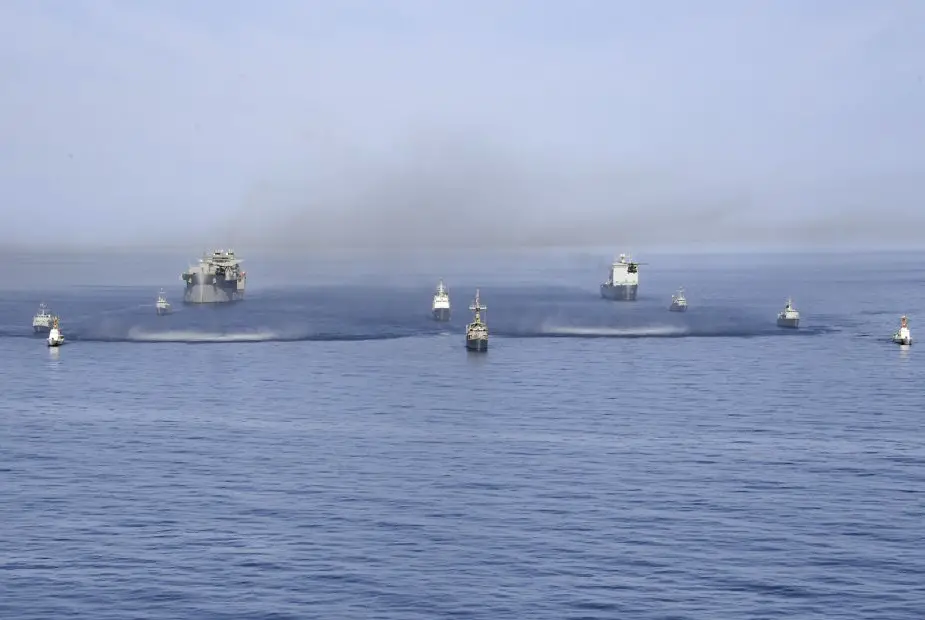Breaking news
U.S., France and UK Navies completed Artemis Trident 19 exercise.
France’s Marine Nationale, the United Kingdom’s Royal Navy and the U.S. Navy completed the U.S. 5th Fleet mine countermeasures exercise Artemis Trident in the Arabian Gulf.

The scenario for the defensive exercise was for coalition forces to provide safe passage to humanitarian relief vessels through a mined area.
“Mines threaten maritime traffic indiscriminately,” U.S. Navy Capt. Jeffrey Morganthaler, Commodore of Task Force 52 and lead for the exercise, said. “Training together ensures we can collectively protect unfettered operations of naval and support vessels, as well as commercial shipping movements, throughout the maritime domain.”
In the fictional scenario, 70 nautical miles of channels and routes were cleared for simulated shipping using multiple, integrated sensors. Geographically dispersed forces practised choking point clearance and harbour breakout.
The exercise involved over 700 personnel, 10 ships, and five helicopters from the three nations. The ships included the U.S. Navy expeditionary sea base USS Lewis B. Puller (ESB 3), fleet ocean tug USNS Catawba (T-ATF 168), Avenger-class mine countermeasures ship USS Sentry (MCM 3), Island-class coastal patrol boats USCGC Maui (WPB 1304) and USCGC Wrangell (WPB 1332); the United Kingdom Royal Navy’s RFA Cardigan Bay (L3009) and minehunters HMS Shoreham (M112) and HMS Ledbury (M30); and the French Marine Nationale’s minehunters FS L’Aigle (M647) and FS Sagittaire (M650).
As part of the exercise, FS L’Aigle and HMS Ledbury simultaneously rafted with the RFA Cardigan Bay. RFA Cardigan Bay’s support increased the endurance of the mine hunters, demonstrating how a multinational force could conduct sustainment and repairs during extended mine clearance operations.
In another scenario, six of the ships practised collective self-defence, working together to defend themselves from simulated air and surface threats.
“The exercise has been a highlight in our current deployment, and it exemplifies how we are stronger together, in an area that is so complex,” said France’s Marine Nationale Lt. Pierre, mine clearance diving officer aboard FS L’Aigle. “France deploys MCM vessels on a regular basis to the Arabian Gulf, to maintain expertise of the local environment, and I am looking forward to the next exercise.”
Command and control was fully integrated throughout the exercise. The Commander UK Mine-Counter Measure Forces and his staff led Combined Task Group 52.2 from aboard the RFA Cardigan Bay, leading RFA Cardigan Bay, HMS Ledbury, FS L’Aigle and a U.S. Navy mine-hunting unit. The United States Navy led Combined Task Group 52.3, focused on expeditionary mine countermeasures with diving forces from all three nations. The French Battle Staff, embarked on USS Lewis B. Puller, served as Combined Task Group 52.4 and led Puller, USS Sentry, FS Sagittaire and HMS Shoreham.
"There are many similarities between all three MCM communities from the comradeship and professionalism onboard these small ships, to the quest to embrace emerging maritime autonomous technology,” Royal Navy Commander Steven White, commander of Combined Task Group 52.2, said. “MCM is a complex and dangerous business that many people do not understand, these exercises allow me along with my fellow task group commanders, and commanding officers of ships and diving units to practice and refine our skills and procedures so we are ready when called upon to do this for real."
Task Force 52 plans and executes mine warfare operations in support of U.S. 5th Fleet operational objectives. U.S. 5th Fleet area of operations encompasses about 2.5 million square miles of water and includes the Arabian Gulf, Gulf of Oman, Red Sea and parts of the Indian Ocean. The expanse comprises 20 countries and includes three critical choke points at the Strait of Hormuz, the Suez Canal and the Strait of Bab al-Mandeb at the southern tip of Yemen.


























